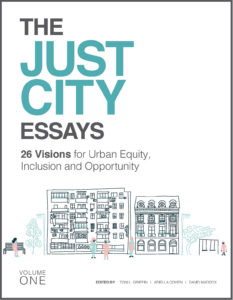“Five years ago, the Harvard Graduate School of Design’s Just City Lab published The Just City Essays: 26 Visions of Inclusion, Equity and Opportunity. The questions it posed were deceptively simple: What would a just city look like? And what could be the strategies to get there? These questions were posed to mayors, architects, artists, philanthropists, educators and journalists in 22 cities, who told stories of global injustice and their dreams for reparative and restorative justice in the city.
 These essays were meant as a provocation, a call to action. Now, during these times of dissonance, unrest, and uncertainty, their contents have become ever more important. For the next 26 weeks [starting June 15, 2020], the GSD and the Just City Lab will republish one essay a week here and at designforthejustcity.org. We hope they may continue conversations of our shared responsibility for the just city.
These essays were meant as a provocation, a call to action. Now, during these times of dissonance, unrest, and uncertainty, their contents have become ever more important. For the next 26 weeks [starting June 15, 2020], the GSD and the Just City Lab will republish one essay a week here and at designforthejustcity.org. We hope they may continue conversations of our shared responsibility for the just city.
We believe design can repair injustice. We believe design must restore justice, especially that produced by its own hand. We believe in justice for Black Americans. We believe in justice for all marginalized people. We believe in a Just City.”
—Toni L. Griffin, Professor in Practice of Urban Planning, founder of the Just City Lab, and editor of The Just City Essays
Turning Migrant Workers into Citizens in Urbanizing China
By Pengfei Xie
One of the root causes of inequity is urban and rural differentiation.
China is experiencing a massive migration to the cities, mostly due to the availability of jobs and better facilities. But the way the government administers “citizenship” also creates inequity and poverty. Since the founding of the People’s Republic of China in 1949, the country has adopted an administrative system of dualistic rural and urban structure in order to promote industrial development and guarantee food security of the then poor nation. The Chinese central government prioritizes urban development over rural development. Rural and urban areas carry out and implement different mechanisms of land ownership, housing, household registration and social welfare policies. Compared to the rural areas, many more resources concentrate into urban districts, including public services, investment and labor forces. This drives huge disparities of employment and wellbeing, and results in the relative poverty of non-urban areas.
With the rapid urbanization in China, millions of farmers leave the land each year for urban jobs. But because they are not allowed to have registered permanent urban residence status—called HUKOU; their residency remains in their original territory—these migrant workers and their families can’t enjoy facilities and services as the non-migrant urbanites do, including social insurance and health care. This has caused inequity, poverty, and the potential for social instability in many Chinese cities. Migrant rural Children in urban areas do enjoy free schooling in theory. But the opportunity costs for school for rural children are higher than urban children. For example, the urban house rent and living expenses are usually unaffordable for them.
With the rapid urbanization in China, millions of farmers leave the land each year for urban jobs. But because they are not allowed to have registered permanent urban residence status—called HUKOU; their residency remains in their original territory—these migrant workers and their families can’t enjoy facilities and services as the non-migrant urbanites do, including social insurance and health care. This has caused inequity, poverty, and the potential for social instability in many Chinese cities. Migrant rural Children in urban areas do enjoy free schooling in theory. But the opportunity costs for school for rural children are higher than urban children. For example, the urban house rent and living expenses are usually unaffordable for them. Continue reading on designforthejustcity.org…
